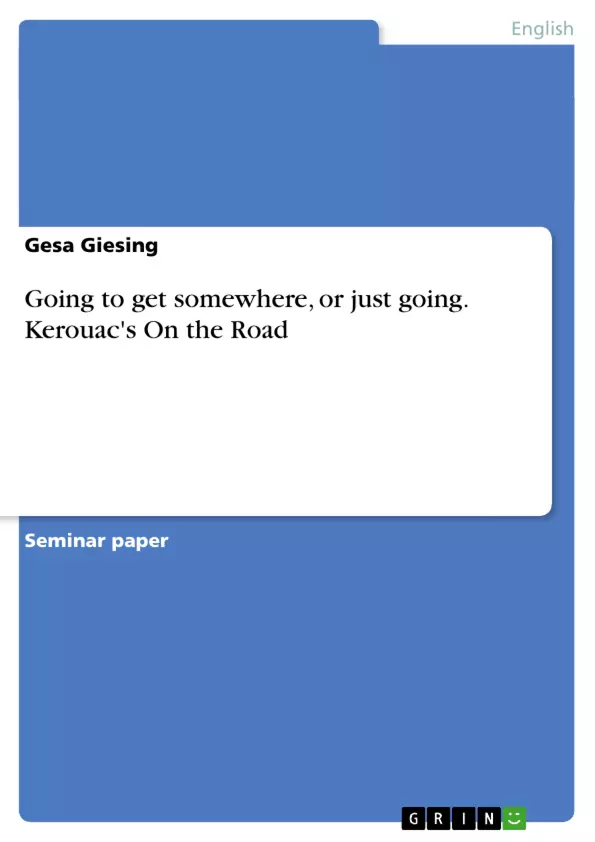INTRODUCTION
What do Copernicus, Jesus, the German Green Party, and say the Impressionists have in common with Jack Kerouac? Obviously, all of them freed themselves from some prevailing belief or technique, or a similar, and introduced a new one instead. With all of them this introduction did not happen without resistance, especially not without resistance by the influential people of the respective branch. In all cases, the new idea experienced trouble to be taken seriously.
When Kerouac tried to publish his novel On the Road, subject of this essay, which he had finished in 1951, he was turned down several times before in 1957 Viking Press would eventually agree on printing the book. Among the things the novel was disapproved of were the way of life depicted in it, breaking with traditions and trespassing moral and legal boundaries, as well as the lack of a new set of guidelines that were to replace the ones trespassed. Had it previously been the introduction of a new set of guidelines (as with Jesus and the Green Party) or beliefs (as with Jesus and Copernicus) or a new technique (as with the Impressionists) that led to dislike, it was now, among other things, the alleged lack of such a set. Schönfelder (1985: 391) discusses in his essay ”Zwischen anarchistischem Protest und Eskapismus” the quality of the Beats’ behavior and comes to the conclusion that they are subjects of the latter: ”Im Endergebnis liegt eine Spielart eines romantischen Eskapismus vor.”. Starting from this I am going to show three things. Firstly, I want to illustrate that the journeys in On the Road are not as aimless as they might seem at a first glance. There is an aim the characters are heading for, hence one must not blame the novel for not offering alternatives to the ideas condemned in it. However, it will become clear that this aim, that is thought to provide happiness by a particular form of freedom, involves certain ways of behavior that do trespass both legal and moral boundaries. In ”On the Road” Asher calls the protagonists’ series of journeys a mere ”joyride” (n.d.: 2). One might indeed consider the novel a praise of unbridled hedonism and individualism. It certainly is -- to some extent. But I will secondly try to show that Sal, the narrator, is very much on the road between traditional and new ideas, i.e. that his physical movement is part of an inner movement. In the end, Sal has become aware of the dreamlike quality of his and his friends’ goal...
Inhaltsverzeichnis (Table of Contents)
- 1 INTRODUCTION
- 2 ON THE ROAD IN EVERY RESPECT
- 2.1 IT
- 2.1.1 WHAT IS IT?
- 2.1.2 HOW IS IT ACHIEVED, OR THOUGHT TO BE ACHIEVED?
- 2.1.3 THE IMPORTANCE OF THE SEARCH FOR IT
- 2.1.4 HOW IS IT REPRESENTED?
- 2.2 THE WEST
- 2.3 LIMITS
- 2.3.1 \"MAYBE WE OUGHT TO GO BACK, THOUGH?\" (293)
- 2.3.2 TWO FURTHER CASES OF DUALISM
- 2.4 SOME REMARKS ON POSTMODERNISM
- 2.4.1 RACE AND GENDER
- 2.4.2 \"EVERYBODY GOES!\"\n
- 2.5 NON-FICTIONAL BEAT LIFE
- 2.1 IT
- 3 CONCLUSION
Zielsetzung und Themenschwerpunkte (Objectives and Key Themes)
This essay examines Jack Kerouac's novel On the Road, focusing on the protagonists' quest for a state of pure enjoyment and freedom, which they refer to as "IT." The essay analyzes the novel's portrayal of this pursuit, exploring its connection to the Beat Generation's rejection of traditional values and the complexities of achieving genuine freedom. The essay also investigates the relationship between the novel's fictional world and Kerouac's own life.
- The search for "IT," a state of pure enjoyment and freedom
- The rejection of traditional values and societal constraints
- The ambiguity and limits of achieving true liberation
- The relationship between fictional and real-life experiences
- The novel's potential foreshadowing of postmodern ideas
Zusammenfassung der Kapitel (Chapter Summaries)
The introduction establishes the context for the essay, comparing Kerouac's novel to other figures and movements that challenged existing norms. The essay also defends On the Road against criticisms that portray the characters' journeys as aimless.
The chapter "ON THE ROAD IN EVERY RESPECT" delves into the nature of "IT," the elusive goal that drives the protagonists. The concept of "IT" is explored through its connection to freedom, the rejection of societal expectations, and the intensity of living life to the fullest.
The chapter "THE WEST" analyzes the novel's portrayal of the West as a symbol of both opportunity and disillusionment, suggesting a breakdown of traditional values and the instability of traditional ideas.
The chapter "LIMITS" examines the limitations the protagonists encounter in their pursuit of "IT." This chapter also explores the theme of dualism, as the characters navigate between traditional and new ideas. The chapter "SOME REMARKS ON POSTMODERNISM" explores the novel's potential foreshadowing of postmodern ideas, specifically in its treatment of gender and race.
Schlüsselwörter (Keywords)
The main keywords of this essay include: On the Road, Jack Kerouac, Beat Generation, freedom, hedonism, individualism, traditional values, societal constraints, "IT," the West, postmodernism, gender, race, fictional representation, real-life experiences.
- Quote paper
- Gesa Giesing (Author), 2001, Going to get somewhere, or just going. Kerouac's On the Road, Munich, GRIN Verlag, https://www.grin.com/document/28617



